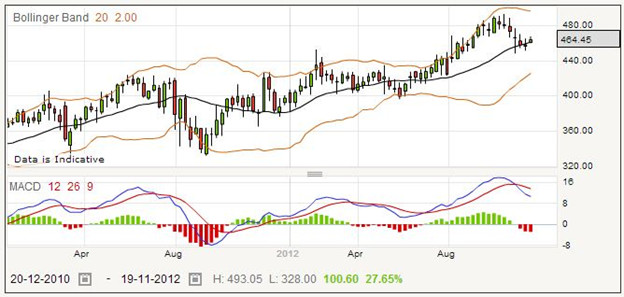Catlin Group is in the business of insurance, specifically specialty insurance and re-insurance with Lloyds of London. The price chart shows that it is a very active stock, which means good opportunities for spread betting but also risks if you are not experienced in trading and need time to react. The chart below is based on weekly prices, but the monthly and daily charts exhibit similar characteristics.

The company is based in Bermuda, and operates around the world. It has the largest syndicate at Lloyd’s of London. It was originally founded by Stephen Catlin in 1984, and he remains the chief executive at the moment. It started as an underwriting agency, forming the first Lloyd’s syndicate (Syndicate 1003) in 1985.
It enjoyed good growth and in 1995 established a second Lloyd’s syndicate (Syndicate 2003), which was backed solely by Catlin Group capital – the previous syndicate had been formed with capital from various Lloyd’s Names, the wealthy people who traditionally take on the insurance risk at Lloyd’s. This was facilitated partly by the injection of a substantial amount of capital from the Western General Insurance Company of Bermuda. The Bermuda-based holding company, now called Catlin Group Limited, was established in 1999, and it was the first of the Lloyd’s of London agents to take this path, which has now been copied by several others.
The Group became public in 2004, with an oversubscribed initial public offering raising nearly $200 million. In 2006 it took over Wellington Underwriting PLC, another large syndicate at Lloyd’s. It now operates with six hub offices, in London, Bermuda, the United States, Europe, Canada, and in the Asia-Pacific region.
For a trading perspective, the frequent changes in trend can be challenging, even though they are lucrative when you trade in their favour. Before actively trading on this stock, you should plan to follow it for a few weeks, and test your trading strategy against the actual price moves.
Catlin Group Rolling Daily
Catlin Group has characteristics that make it suitable for the active and experienced trader. The current price for a rolling daily bet is 462.94 – 465.26. If you think that the price will be going up, then you could place a long bet, buying at the price of 465.26 for a stake of, say, £2.50 per point.
Assuming this works out, it may be that you are able to close your bet for a win when the price goes up to 536.51 – 538.89. A long bet closes on the lower or selling price, which in this case is 536.51. The starting price for your bet was 465.26, and the closing price was 536.51, which means you have gained 536.51 minus 465.26 points, which works out to 71.25 points. With a wager of £2.50 per point, you would have won £178.12.
Everyone has their share of losers, and you should not expect that any particular trade will turn out in your favour. If this one did not, you might find that you needed to close the position and accept your loss when the price dropped to 403.16 – 405.79. With a closing price this time of 403.16, you have lost 465.26 minus 403.16 points, which is 62.10 points. For your size of bet, this works out to a loss of £155.25.
One of the secrets of successful spread betting is to minimize any inevitable losses. It can be useful to set a stoploss order on your bet when you take it out, so that the position will be closed by your spread betting provider automatically if the price goes in the wrong direction. In this case, a stoploss order might have closed your losing position when it reached 415.31 – 417.96. The opening price was 465.26, as before. This time the bet closed at 415.31. The difference between these is 49.95 points, so your loss would be £124.88.
Catlin Group Futures Style Bet
With a longer perspective on trading the Catlin Group, you may decide to take out a futures based bet. The far quarter spread bet, expiring in about eight months, is currently priced at 463.96 – 469.56. Even if you choose a futures style bet, you are at liberty to close the trade for a win or a loss whenever you want, right up to the expiry date. Say you think that Catlin shares are going down, you might place a short bet, selling at 463.96 for £3 per point.
As a first example, perhaps the share price goes down as you hope and you are able to close your trade when the price is 408.63 – 414.23. A short bet closes on the higher price, in this case 414.23. It is easy to remember which price to use whether you are betting up or down, as it works to minimize any wins and maximize any losses that you have. It has to, as your spread betting provider is paid by the difference in the spread. This time you have made 463.96 minus 414.23 points, which is 49.73 points. Multiplying by your stake of £3 per point this works out to a profit of £149.19.
If your bet did not work out, you might find that you were forced to close for a loss when the price went up to 497.32 – 502.54. Your bet closes at 502.54, which means you have lost 38.58 points from your starting position. Multiplying by £3, this is a loss of £115.74.
To help you control your losses, you may choose to use a stop loss order, which will take you out of the losing position even if you are not watching the markets. In this case a stoploss order might have closed your losing trade at 483.59 – 488.97. With a closing price of 488.97 and an opening price of 463.96, this time you would have lost 25.01 points which amounts to a loss of £75.03.